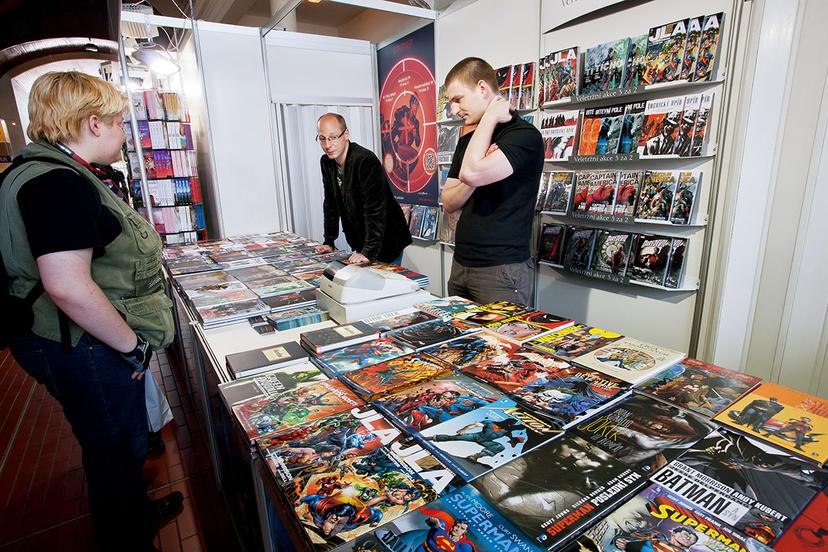Comic Books and Graphic Novels

Industry Outlook
The Bureau of Labor Statistics does not provide labor-market data at a level of detail that identifies trends for the comic book industry or for the specialized writers, artists, and editors who work in it.
The BLS classifies comic book artists within the larger category of fine artists, including painters, sculptors, and illustrators. Little or no change in employment is projected for this occupational category through 2028.
Similarly, the BLS includes comic book writers within a larger category, writers and authors, for which growth is expected to remain flat through 2028. Like most workers in highly creative fields, artists and writers will face strong competition for jobs.
For editors working in all forms of publishing, the BLS projects a -3 percent decline through 2028.
Because these BLS figures apply to large occupational categories rather than to workers who create comic books and graphic novels, it may be more useful to infer employment trends by looking at the overall performance of the industry.
The 2020 coronavirus pandemic hurt the comic books industry. Unlike novels and streaming video , the appeal of the comic books industry largely relies on in-person interaction and physical media. Early in the pandemic, Diamond Comic Distributors, who handles 75 percent of comic book distribution in the U.S., temporarily shut down. This cut off the supply of new product to specialty comic book stores and led publishers to cut back on producing new content. Comic book shops themselves and online retailers experienced an increase in sales of back issues and existing inventory, such as trade paperback collections and graphic novels. The research group IBISWorld projected about a 13 percent decline in revenue for the comic book publishing industry in 2020. By late 2020, however, distribution had resumed, and the industry began to recover from the stoppage.
If anything, the cancellation of comic industry conventions turned people's attention even moreso to their comic collections. Demand for comics has grown since shipping resumed in 2020. According to a December 2020 Hollywood Reporter article, industry experts report that the comics market is stabilizing. Many collectors have been focusing on cleaning up their collections, which has helped to grow sales of everything from new titles and graphic novels to back issues. Crowfunding has also been critical in helping comics stores to continue operating. The stories and creativity that comics and graphic novels bring to people have been welcome respites throughout the pandemic and will continue to be popular in post-pandemic times. A Market Watch report predicts that the global comic book market will grow by about 3 percent annually through 2026.
Industry Trends
According to, Comichron and ICv2, with the exception of a slight dip in 2017, North American comic sales have been trending upward over the previous seven years. From $805 million in 2012, sales climbed to almost $1.09 billion in 2016. After falling slightly to $1.02 billion in 2017, sales reached a high of nearly $1.10 billion in 2018. Several factors contributed to the record figure, including the inclusion of newsstand and crowdfunding-related sales (which comprised a new "Other" category in the annual Comichron/ICv2 analysis), and an uptick in both digital and book channel sales.
Though still the dominant sales channel, comics stores accounted for less than half of the total market for the first time in approximately 30 years, signifying what ICv2's Milton Griepp described as a "historic shift" in a related Comichron article. Double-digit increases occurred in the book channel, which not only included online retailers, major chains, and mass merchants, but also Scholastic Book Fairs, reflecting the growing popularity of graphic novels with children. For the first time in several years, Comichron noted that digital sales also increased in 2018.
Another trend is the increasing acceptance of art from the comics as fine art. Pop artist Roy Lichtenstein controversially imitated the style of comic books in his 1960s paintings, but artwork from actual comic books is now being scanned and reproduced in high-quality art book editions, some of them portfolio-sized.
Implications for Occupations
The trend toward digital platforms indicates that job opportunities will be better for artists who are skilled with using computers. Although many artists still begin the creative process by working in pencil, hand-drawn images often are scanned into computers at some stage during the process and manipulated digitally from then on. Some artists use a Wacom tablet to draw directly within the graphics program. On the other hand, writers do not need much more technical ability than it takes to operate a word processor and communicate via e-mail.
Most comic book artists collaborate with writers, and all have to work with editors. Artists and writers who fit the stereotype of the self-centered creative genius have more limited opportunities in this field. Most artists and writers are freelancers and have to compete to get assignments from editors, which is why self-promotion is important. Artists and writers should be comfortable with using Facebook, Twitter, blogs, and Web sites to create a high profile for themselves. They also should attend comic-book conventions to keep up with trends in the industry and make contacts with editors and potential collaborators.
The shift to digital platforms probably will limit opportunities for jobs in retail comic shops and in the distribution network that supplies them. The industry will generate work for software developers as it continues to experiment with formats for digital delivery. Best opportunities will be for those who are skilled with code that displays and manipulates graphics. The usual trend in software development is that once the highly innovative phase has passed, maintenance and bug-fixing work is given to lower-paid offshore workers.
